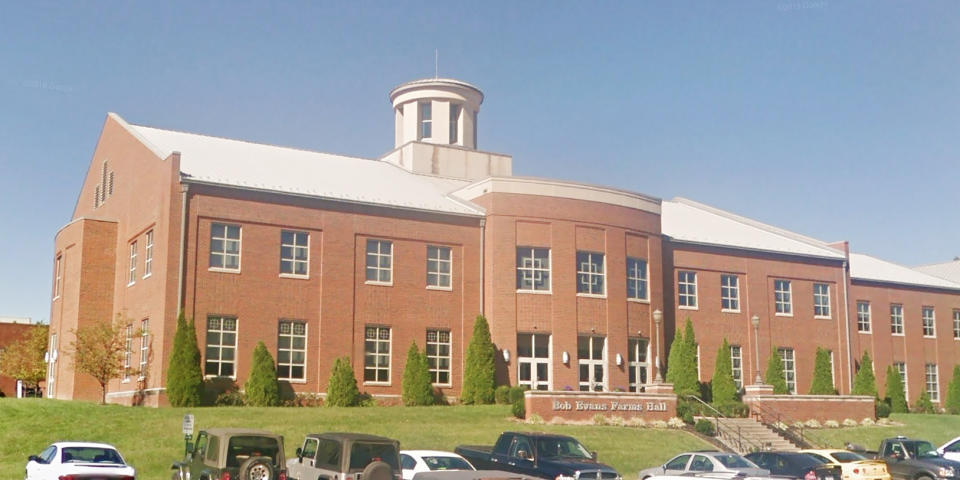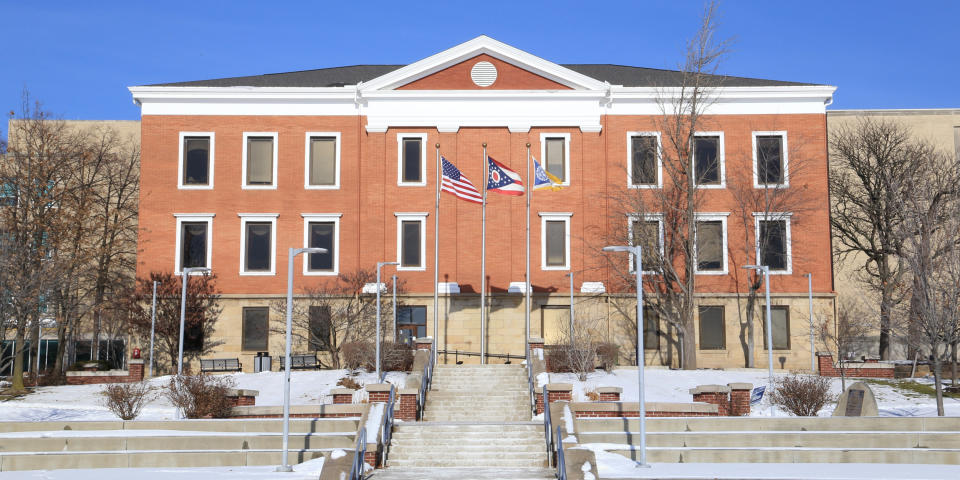A catastrophe is looming for U.S. colleges. This analysis shows just how bad it is.
This article about college financial health was produced in partnership with The Hechinger Report, a nonprofit, independent news organization focused on inequality and innovation in education. This is part 1 of the Colleges in Crisis series.
Dozens of colleges and universities nationwide started 2020 already under financial stress. They’d spent the past decade grappling with declining enrollments and weakening support from state governments.
Now, with the added pressures of the coronavirus pandemic, the fabric of American higher education has become even more strained: The prospect of lower revenues has already forced some schools to slash budgets and could lead to waves of closings, experts and researchers say.
To examine how institutions were positioned to respond to such a crisis, The Hechinger Report created a Financial Fitness Tracker that put the nation’s public institutions and four-year nonprofit colleges and universities through a financial stress test, examining key metrics including enrollment, tuition revenue, public funding and endowment health.
Schools faring the worst in these areas — meaning that they are projected to dip under the 20th percentile in a particular category — are marked with warning signs in the tracker. A total of 2,662 schools were included in the analysis, and 2,264 had enough data to be evaluated in every category. All data predates the pandemic.
Our analysis of the stress test results found:
Nationwide, more than 500 colleges and universities show warning signs in two or more metrics.
The problems were not evenly spread among states. Combined, Ohio and Illinois have more than 10 percent of all the institutions potentially facing trouble. Ohio has 36 institutions with two or more warning signs. Illinois has 26.
Roughly 1,360 colleges and universities have seen declines in first-year fall enrollment since 2009, including about 800 four-year institutions.
Nearly 30 percent of all four-year schools brought in less tuition revenue per student in 2017-18 than in 2009-10.
About 700 public campuses received less in state and local appropriations in 2017-18 than in 2009-10, and about 190 private four-year institutions saw the size of their endowments fall relative to their costs.
Many factors can cause colleges to struggle financially, according to a review of the data and interviews with 39 college finance researchers, student advocates, state officials, school administrators and faculty members. Over the last decade, enrollment slipped as the economy grew. Demographics are working against institutions in parts of the country as the number of teens — and thus the number of high school graduates — drops. State support still lags behind what it was before the Great Recession. Many colleges and universities have a history of mismanaging their finances, increasing spending even as enrollments fell or going deeply into debt to construct new buildings.
At worst, institutions under financial stress can fold — sometimes overnight, as government and accrediting oversight fails to prevent precipitous closures that throw students’ lives into disarray. Even in the case of orderly closings, students’ educations can be significantly disrupted — many drop out and never finish their degrees.
More than 50 public and nonprofit institutions have closed or merged since 2015, and experts expect to see more closures in the coming academic year. Even if colleges manage to stay open, they may have to make deep cuts to do so, which could ultimately hurt students as well.
“Think of the revenue shocks these universities are suffering,” said Gregory Price, an economics and finance professor at the University of New Orleans, noting that if students aren’t on campuses for the coming academic year or choose not to attend at all, schools could miss out on even more. “I don’t want to sound too alarmist, but this could possibly be devastating.”
The “stress test” that informed The Hechinger Report’s Financial Fitness Tracker was developed by Robert Zemsky, a University of Pennsylvania education professor; Susan Shaman, the former director of institutional research at Penn; and Susan Campbell Baldridge, a professor and former provost at Middlebury College. Their methodology draws on a uniform set of federal data that most schools have reported steadily over the past decade and allows public and private institutions to be scored according to similar standards. (For-profit schools are not included in their methodology.)
The Hechinger Report’s Financial Fitness Tracker takes the researchers' “stress test” and applies it to individual schools to make the scores transparent and public.
For private colleges, the Hechinger Report tool tracked enrollment, retention, average tuition revenue per student and endowment-to-spending ratios. For public four-year colleges, the metrics were enrollment, retention, average tuition revenue per student and state funding. And for public two-year colleges, the analysis checked enrollment, state and local funding and the ratio of tuition revenue to instructional costs.
Related: Enrollment and financial crises threaten growing list of academic disciplines
The stress test is not a crystal ball to predict closures. Many colleges on the verge of collapse remain that way for years, continually finding ways to survive. Others, whose circumstances may look less dire, can close suddenly. Interpreting the nuances of any given institution’s financial situation is complicated.
Even so, experts say the metrics in the tool provide valuable insights. “They’re a really great starting point,” said Doug Webber, an associate economics professor at Temple University. Enrollment and tuition revenue, in particular, “don’t tell you everything, but they get you a lot of the way there.”
For more of NBC News' in-depth reporting, download the NBC News app
A deeper look at Ohio, which is one of the centers of the nation’s higher education financial crisis, shows how these trends interact to create different forms of financial stress at different types of institutions. In Ohio, state budget cuts and a declining population of teens have combined to create financial struggles for schools. Ohio has lagged behind the national average in restoring funding to higher education following the 2008 recession. All kinds of institutions — from large public universities to small private schools — face challenges.
“We’re just swimming deep in the ocean right now,” said Chris Pines, a former full-time philosophy and humanities professor at the University of Rio Grande in southeastern Ohio, who recently lost his position due to the school's financial problems. “We’re treading water and there’s no raft. I don’t know what the long-term future looks like.”
Enrollment declines lead to difficult cuts
Colleges have lost hundreds of thousands of students since 2010, when undergraduate enrollment peaked at just above 18 million. That figure declined to 16.6 million in 2018. Nearly 600 two- and four-year institutions saw their incoming fall enrollments drop more than a quarter in that time period.
“If your enrollment is cratering, then you’re probably not going to be raising tuition, because that’s just going to compound the problem,” Temple University’s Webber said. “So you’re going to be spending less.”
The University of Rio Grande, a private four-year university in the foothills of the Appalachian Mountains, has struggled with falling enrollment for years. The university, which partners with the public Rio Grande Community College, plays an important role for the surrounding counties, which include some of Ohio’s poorest residents. About half of the students at the two schools receive Pell Grants, a form of federal aid for low-income students.

Both institutions have recently faltered. Their combined enrollment fell from 3,264 students in 2012-13 to 2,227 in 2018-19, according to federal data. The number of high school students in Ohio has dropped within the last decade, leading to fewer high school graduates, according to state and federal data. Those who do enroll at Rio Grande’s campuses often don’t stay; annual retention rates hover just above 50 percent for full-time students and are often even lower for part-time students.
Related: With enrollment sliding, liberal arts colleges struggle to make a case for themselves
In April 2019, Rio Grande faculty secretly held a vote of no confidence in the schools’ governing boards, alleging that administrators had kept spending as if the supply of new students would keep increasing. The board’s mistakes, the faculty argued, had led to “persistent and severe budget deficits.”
Shortly after that no-confidence vote, 18 professors — about a fifth of the full-time faculty — were told they would be let go, according to Rio Grande officials. (Two were brought back full-time and two will work as part-time adjuncts.) Programs that were deemed too small were eliminated entirely, such as the school’s music program.
Pines, who was among the 18 let go and will only be teaching part-time this fall, said many faculty viewed the budget problems as a “foreseeable train wreck.”
The reductions saved the school nearly $1 million, according to Ryan Smith, the university’s president, who assumed his role in October 2019, after the cuts had been made. He said he understood the frustration of faculty members, but that the downsizing had been necessary. “We kind of bottomed out as far as what we were offering before,” he said.
Pines says he can’t completely fault the prior administration for making the tough cuts, but he worries for recent and future graduates: “How would the bigger world perceive the value of our degree if, basically, you gutted most of your qualified faculty?”
Related: Some colleges seek radical solutions to survive
Smith has restructured some of the university’s debt to fully fund pension liabilities and hired a marketing director; the administration also added more sports teams to try to attract students. Smith projects enrollment growth this fall and believes the school will ultimately be able to increase the number of programs it offers. When that happens, it’ll be a challenge to figure out “how do we grow back to where we were?” he said. “But we’ve got to be able to survive today.”
State funding cuts add to financial problems
As in most states, Ohio’s higher education system hasn’t fully recovered from the recession of a decade ago. In 2018, the state was still spending 17 percent less per student than it spent in 2008. Nationally, that figure was 13 percent less. More than half of public campuses nationwide have had state and local appropriations decrease since 2008, according to federal data.
Higher education finance experts predict more cuts ahead for public institutions as the coronavirus decimates state budgets. Some have already started. In May, Ohio Gov. Mike DeWine, a Republican, announced $110 million in higher education cuts, a nearly 4 percent budget reduction for each institution.
Eighteen Ohio institutions lost more than $1 million each. The cut for the University of Akron, for instance, was more than $3.7 million. The school had already run deficits for the last three years and, in late spring, announced that it needed to shave $65 million from its $325 million budget. In mid-July, the board of trustees voted to eliminate 97 full-time professor positions — more than 1 in 6 at the university — and 60 other staff members. (The plan still needs to be ratified by the union.)
Related: Budget cuts are taking the heaviest toll on colleges that serve the neediest students
The budget cut was based on “significant” revenue losses from the spring campus closure, enrollment projections and state funding trends, Christine Boyd, director of media relations, said in an email.
“Throughout the budget process, great care has been taken to preserve academic quality and ensure that support services — from financial aid to academic support — remain strong to help our students on their degree journey,” Boyd added.

Lt. Gov. Jon Husted suggested in June to the news website Cleveland.com that there were limits to how much the state could help struggling institutions. “You can never subsidize something enough to escape the laws of economics,” he said.
Husted told The Hechinger Report that the state intended to continue supporting higher education but had to balance the budget. He added that the higher education landscape had already been changing, with students concerned about the cost of a degree and looking for other options.
“They’re facing great challenges,” he said, adding that the colleges that can adapt will succeed. “That’s just the reality.”
Pamela Schulze, a family studies professor at the University of Akron and its faculty union president, says the state has to help public colleges and universities survive, including by providing more funding. “Of course the state can do something about it, because it’s the state university system,” Schulze said. “If they leave their university system in tatters, we really are not going to be able to fulfill our role in the state of Ohio.”
Schools with shrinking endowments scramble to raise money
State money and tuition are not schools’ only sources of funds. Many colleges and universities rely on money from their endowments, particularly to weather financial storms. Schools typically draw down a percentage of their endowments every year, trying to spend only the interest and keep the funds growing.
The larger their endowment, the less schools have to rely on other sources of revenue, and the greater financial stability they have. But about 330 schools in our tracker saw their endowments decrease over the last decade relative to their costs, according to federal data; 57 percent were private institutions.
Among them is Wilberforce University, a historically Black university outside of Dayton, Ohio. Its endowment dropped from $12 million in 2014 to $8.2 million in 2018.
The median endowment for historically Black colleges and universities is half that of other colleges and universities of the same size, according to a 2018 report from the Government Accountability Office. Schools with small endowments were already in a precarious position, Price, the University of New Orleans professor, said. Now, he added, coronavirus-related revenue losses threaten to make it even harder for these schools to survive.
“It’s going to be very challenging for a place like Wilberforce to sustain itself,” Price said.
Related: Already stretched universities now face tens of billions in endowment losses
Wilberforce is currently on probation with its accreditor because of financial problems; the issues stretch back for years. In 2012, hundreds of students demanded transfer applications as a protest because “we’re not getting our quality education,” as one student put it, according to a local news report. In 2013, students held another protest, holding signs saying “Fix the dorms now” and “Broken promises,” according to a news report.

In the spring of 2019, Wilberforce’s president, Elfred Pinkard, announced an ambitious effort to raise $2 million in about two months and $5 million by the end of the year. Wilberforce fell well short of those goals, but, buoyed by a $1.2 million anonymous gift last fall, coupled with $1.7 million in loan forgiveness, Pinkard said, they met the $5 million goal in June.
Fundraising is a crucial way to boost endowments, but Price said HBCUs have historically struggled to get philanthropists’ attention, despite the important role they play in helping Black Americans achieve upward mobility. To survive, schools must find ways to persuade more donors to give.
Pinkard, who was appointed at the end of 2017, remains optimistic. In response to student concerns raised during the protests, members of the board of trustees were replaced. Officials have renovated and repaired campus buildings and started a dual-enrollment program for nearby high schoolers.
“We have been very intentional and disciplined in our attention to charting a sustainable path forward,” Pinkard said in a statement. “We join the community of institutions in higher education who are all vulnerable but determined to reimagine higher education in a post-COVID-19 environment.”
Still, with too many colleges competing for a shrinking pool of students and the consequences of the coronavirus bearing down, higher education may face tumultuous years ahead, Price warned.
“A lot of underendowed, financially fragile institutions are going to have to shut their doors, unfortunately,” he said.
Sign up for The Hechinger Report’s higher education newsletter.

